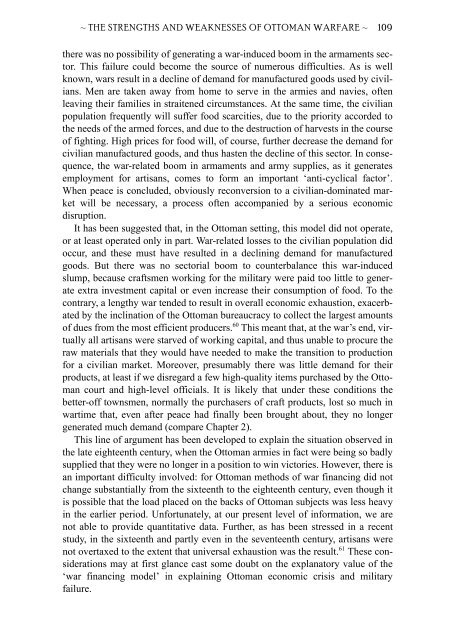The Ottoman Empire and the World Around It - Course Information
The Ottoman Empire and the World Around It - Course Information
The Ottoman Empire and the World Around It - Course Information
You also want an ePaper? Increase the reach of your titles
YUMPU automatically turns print PDFs into web optimized ePapers that Google loves.
~ THE STRENGTHS AND WEAKNESSES OF OTTOMAN WARFARE ~ 109<br />
<strong>the</strong>re was no possibility of generating a war-induced boom in <strong>the</strong> armaments sector.<br />
This failure could become <strong>the</strong> source of numerous difficulties. As is well<br />
known, wars result in a decline of dem<strong>and</strong> for manufactured goods used by civilians.<br />
Men are taken away from home to serve in <strong>the</strong> armies <strong>and</strong> navies, often<br />
leaving <strong>the</strong>ir families in straitened circumstances. At <strong>the</strong> same time, <strong>the</strong> civilian<br />
population frequently will suffer food scarcities, due to <strong>the</strong> priority accorded to<br />
<strong>the</strong> needs of <strong>the</strong> armed forces, <strong>and</strong> due to <strong>the</strong> destruction of harvests in <strong>the</strong> course<br />
of fighting. High prices for food will, of course, fur<strong>the</strong>r decrease <strong>the</strong> dem<strong>and</strong> for<br />
civilian manufactured goods, <strong>and</strong> thus hasten <strong>the</strong> decline of this sector. In consequence,<br />
<strong>the</strong> war-related boom in armaments <strong>and</strong> army supplies, as it generates<br />
employment for artisans, comes to form an important ‘anti-cyclical factor’.<br />
When peace is concluded, obviously reconversion to a civilian-dominated market<br />
will be necessary, a process often accompanied by a serious economic<br />
disruption.<br />
<strong>It</strong> has been suggested that, in <strong>the</strong> <strong>Ottoman</strong> setting, this model did not operate,<br />
or at least operated only in part. War-related losses to <strong>the</strong> civilian population did<br />
occur, <strong>and</strong> <strong>the</strong>se must have resulted in a declining dem<strong>and</strong> for manufactured<br />
goods. But <strong>the</strong>re was no sectorial boom to counterbalance this war-induced<br />
slump, because craftsmen working for <strong>the</strong> military were paid too little to generate<br />
extra investment capital or even increase <strong>the</strong>ir consumption of food. To <strong>the</strong><br />
contrary, a lengthy war tended to result in overall economic exhaustion, exacerbated<br />
by <strong>the</strong> inclination of <strong>the</strong> <strong>Ottoman</strong> bureaucracy to collect <strong>the</strong> largest amounts<br />
of dues from <strong>the</strong> most efficient producers. 60 This meant that, at <strong>the</strong> war’s end, virtually<br />
all artisans were starved of working capital, <strong>and</strong> thus unable to procure <strong>the</strong><br />
raw materials that <strong>the</strong>y would have needed to make <strong>the</strong> transition to production<br />
for a civilian market. Moreover, presumably <strong>the</strong>re was little dem<strong>and</strong> for <strong>the</strong>ir<br />
products, at least if we disregard a few high-quality items purchased by <strong>the</strong> <strong>Ottoman</strong><br />
court <strong>and</strong> high-level officials. <strong>It</strong> is likely that under <strong>the</strong>se conditions <strong>the</strong><br />
better-off townsmen, normally <strong>the</strong> purchasers of craft products, lost so much in<br />
wartime that, even after peace had finally been brought about, <strong>the</strong>y no longer<br />
generated much dem<strong>and</strong> (compare Chapter 2).<br />
This line of argument has been developed to explain <strong>the</strong> situation observed in<br />
<strong>the</strong> late eighteenth century, when <strong>the</strong> <strong>Ottoman</strong> armies in fact were being so badly<br />
supplied that <strong>the</strong>y were no longer in a position to win victories. However, <strong>the</strong>re is<br />
an important difficulty involved: for <strong>Ottoman</strong> methods of war financing did not<br />
change substantially from <strong>the</strong> sixteenth to <strong>the</strong> eighteenth century, even though it<br />
is possible that <strong>the</strong> load placed on <strong>the</strong> backs of <strong>Ottoman</strong> subjects was less heavy<br />
in <strong>the</strong> earlier period. Unfortunately, at our present level of information, we are<br />
not able to provide quantitative data. Fur<strong>the</strong>r, as has been stressed in a recent<br />
study, in <strong>the</strong> sixteenth <strong>and</strong> partly even in <strong>the</strong> seventeenth century, artisans were<br />
not overtaxed to <strong>the</strong> extent that universal exhaustion was <strong>the</strong> result. 61 <strong>The</strong>se considerations<br />
may at first glance cast some doubt on <strong>the</strong> explanatory value of <strong>the</strong><br />
‘war financing model’ in explaining <strong>Ottoman</strong> economic crisis <strong>and</strong> military<br />
failure.


